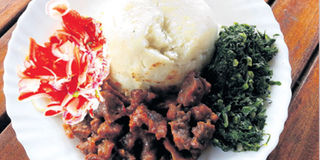Delicious pork with ‘kachumbari’ and ‘ugali’

One of the most common misconceptions about pork is that it needs to be cooked for a long time to kill parasitic worms. PHOTO | NATION
What you need to know:
- One of the most common misconceptions about pork is that it needs to be cooked for a long time to kill parasitic worms. In the past, any sign of pink in a grilled pork chop or roasted pork loin was cause for alarm. Unfortunately, that means that generations of people have been eating overcooked pork, which is basically tough and dry and lacking in flavour.
Last week, we talked about the different kinds of pork cuts.
Hopefully, next time you go to buy pork, this knowledge will help you choose the best part. Today, we will discuss some key facts about cooking pork as well as some misconceptions about how pork should be cooked.
One of the most common misconceptions about pork is that it needs to be cooked for a long time to kill parasitic worms. In the past, any sign of pink in a grilled pork chop or roasted pork loin was cause for alarm. Unfortunately, that means that generations of people have been eating overcooked pork, which is basically tough and dry and lacking in flavour.
The good news is that hygiene standards during the rearing, slaughtering, and handling of pork have greatly improved and chances of contamination reduced. You, therefore, do not have to overcook pork.
Pork with ‘kachumbari’ and ‘ugali’.
Ingredients:
- Pork cubes, preferably from the leg, minus the bone and skin
- Onion
- Garlic
- Oil
‘Kachumbari’ Ingredients:
- 2 tomatoes (diced)
- 1/2 medium onion (diced)
- 1/2 bunch dhania (chopped)
- Chilli (optional)
- Lemon juice
- Salt and pepper
Procedure:
1. Heat a sufuria until hot with very little oil if using pork without skin or fat. You know the sufuria is hot when it starts to smoke.
2. Add the cubed pork, starting with the one with the skin, and cook for about two minutes with the fire on high. This is to allow the skin to cook, since it takes a longer time to be ready.
3. When the meat starts to brown, add the rest of the meat without skin, stir once, and allow to brown. The trick is to use high heat and a large sufuria/pot so that the meat does not start to produce water, hence stewing)
4. When meat is browned slightly, add the onion and garlic and stir.
5. Reduce the heat when the pork is fully browned, then stir in the garlic and onion.
6. Cover pot to allow the pork to cook.(It should take about 10 minutes)
7. When the pork is cooked, some fat will have accumulated. Drain it if it is too much. Add salt and pepper to taste.
8. Increase the heat to make the pork have a deeper brown colour and if its sticking to the pot, add a little water.
9. When ready, the pork should have a nice golden brown colour and a caramelised taste. If using pork with some bones, keep cooking until the meat is cooked and the juices running out of the bone are clear.
10. Meanwhile, mix all the kachumbari ingredients in a bowl.
11. Turn off the heat when the meat is cooked, pour the kachumbari into the meat in the pot, stir, but do not allow it to cook.
12. Serve immediately with ugali.
For any comment or feedback, follow me @chefraphaelkn or Like my page facebook.com/chefraphael to get more cooking tips and recipes.




